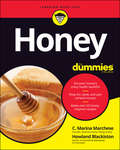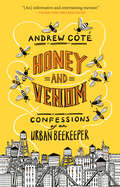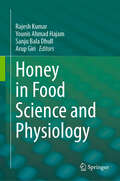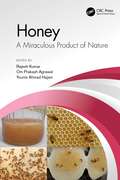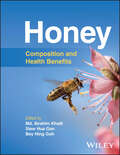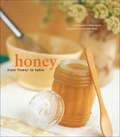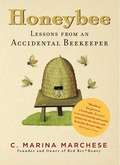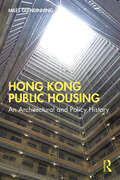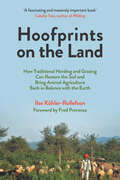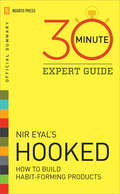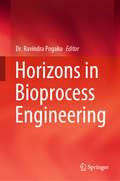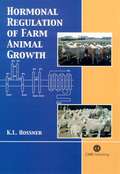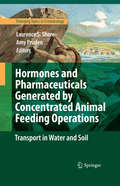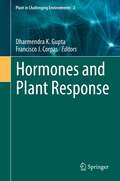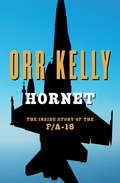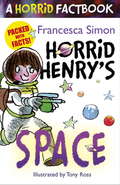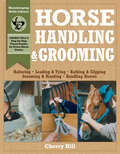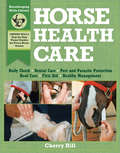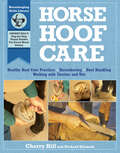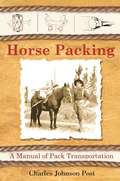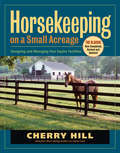- Table View
- List View
Honey For Dummies
by Howland Blackiston C. Marina MarcheseGet in on the ground level of the next artisan food obsession—honey! Just like wine, cheese, beer or coffee, honey is an artisan food with much to be discovered. Whether you're interested in tasting the various varietals, using it as a cure, or harvesting your own, Honey For Dummies is the guide for you. This book reveals the deep and complex world of honey, its diverse floral sources, and its surprising range of colors, smells, and flavors. You will learn about over 50 single-origin honeys, their sensory profiles, where they are produced and where to buy them. Discover how to taste and evaluate honey using the same methods as professional honey sensory expert. Understand how honey is produced by honeybees, and how beekeepers harvest, and bottle this liquid gold. You'll also discover the historical role honey has played around the world in folklore, religions, and economies. From its health benefits, to recipes, to food pairings, this complete guide covers all things honey! Honey is the latest food trend that can be found at farmers' markets, specialty food shops and on the menu of restaurants. It is produced from bees in every state and just about every country on the planet. Let Honey For Dummies accompany you on your sweet adventure! Discover the rich and complex world of single-origin honey Learn about honey's composition and its myriad health benefits Acquire the skills to taste honey like a pro then how to perfectly pair honeys with all foods Try the book's many wonderful recipes that incorporate honey Honey For Dummies is the perfect companion for every chef, brewer, homesteader, beekeeper or honey lover.
Honey and Venom: Confessions of an Urban Beekeeper
by Andrew CotéA year in the life of New York City&’s premier beekeeper, who chronicles his adventures and the quirky personalities he encounters while spreading his infinite knowledge of and passion for the remarkable honey bee. &“Coté&’s charming and poignant essay collection delivers the entertainment and smarts required to make real change in how we look at our planet—and ourselves.&”—Andrew ZimmernConsidered an &“industry legend&” by The New York Times, Andrew Coté has one of the most intriguing, challenging, and unique jobs in New York City—maintaining millions of honey bees atop some of the city&’s most iconic buildings. His apiaries have crowned the Waldorf Astoria and the Museum of Modern Art; reside on the North Lawn of the United Nations; reign above stores, hotels, restaurants, schools, churches, and synagogues; and are situated in community gardens, and even cemeteries, throughout the five boroughs. In this debut collection, Coté takes readers with him on his daily apiary adventures over the course of a year, in the city and across the globe. Here, among his many duties, he is called to capture swarms that have clustered on fire hydrants, air-conditioning units, or street-vendor umbrellas. Annually, he travels with his father to regions like remote Fijian islands, rural Uganda, Haiti, Ecuador, or Iraq with his organization, Bees Without Borders, where he teaches beekeepers how to increase their honey yield and income via beekeeping endeavors. Written with Coté&’s trademark humor, acumen, and a healthy dose of charm, Honey and Venom illuminates the obscure culture of New York City &“beeks&” and the biology of the bees themselves, from the humble drone to the fittingly named worker to the queen herself—who is more a slave than a monarch. The hive world, Coté reveals, is full of strivers and slackers, givers and takers, and even some insect promiscuity—startlingly similar to the prickly human variety. For Coté, a fourth-generation beekeeper, this is a family tradition, and this personal significance pervades his celebration of the romance and mystery of bees, their honey, and the beekeepers whose lives revolve around these most magical creatures.
Honey in Food Science and Physiology
by Rajesh Kumar Sanju Bala Dhull Younis Ahmad Hajam Arup GiriThis book highlights the science underlying honey, which is central to an understanding of conventional medicine or ingredients of food used mostly in all societies and it is attracting increasing interest among food scientists and professionals worldwide. Honey, wax, propolis and royal jelly also have significant roles in various nutraceutical and pharmaceutical products and this book provides collective information and practical approaches regarding all characteristic features of honey and its applications as functional food and medicines. Not only does this book explain the comprehensive knowledge of honey and its medicinal properties based on current researched evidence, it also explores the contribution of honey in the food science and medicine industry as a significant part of nutraceuticals and functional food research. Written by leading scientists in the field, the book will be a valuable resource for students and researchers in the fields of food chemistry, nutritional science, taste physiology, and neuroscience, as well as for professionals in the food industry.
Honey: A Miraculous Product of Nature
by Rajesh Kumar Om Prakash Agrawal Younis Ahmad HajamHoney is a supersaturated solution of sugar made by bees. Honeybees collect a liquid secretion from flowers, called nectar, and take this back to their hives. It is an appreciated natural gift to humanity derived entirely from honeybees. Honey is the by-product of nectar collected by bees from the flowers, with some digestive enzymes produced by the honeybees themselves. Honey: A Miraculous Product of Nature summarizes the current status of honey, it’s uses and related aspects. This illustrated volume describes use of honey in traditional medicines, i.e. Ayurveda, Siddha, and Unani by acting as a preservative and nourishing agent. Also, other properties like digestibility, palatability, deliciousness, refreshing, thirst quencher, stomachic, anti-obtrusive, expectorant, anti-oxidative, anti-tussive and blood purifier are explained in beautiful manner. The role of honey in improving eyesight, strengthens gums and teeth and it’s use in jaundice, spleen enlargement, sore throat, chest diseases, sexual debility, renal and cystic calculi, intestinal worms, heart diseases and leprosy is very well described. The compiled knowledge from range of bee scientists, Honey: A Miraculous Product of Nature aims to provide broad knowledge on honey to the researchers, apiculturists and students to continue their work on honey and honeybees.
Honey: Composition and Health Benefits
by Md. Ibrahim Khalil Siew Hua Gan Bey Hing Goh Zhejiang UniversityHoney A vital understanding of the health effects of this renowned natural food Honey is among the most famous and widely available natural food products in the world, and its flavor profiles are well understood. Despite its use as a natural remedy by many societies, however, there has until recently been no systematic attempt to assess the scientific basis for claims about honey’s health benefits. The ubiquity of honey and honey-derived natural remedies make such an assessment highly desirable. Honey: Composition and Health Benefits offers a systematic assessment for the first time, analyzing the substances that make up honey and their health effects, both separately and in combination. Dedicating full chapters to each of honey’s constituent materials, this book provides the first full-length and comprehensive treatment of this natural food. It also includes content on other honey products such as royal jelly, propolis, and bee venom. It promises to shed scientific light on centuries of tradition. Honey readers will also find: Detailed treatment of honey’s constituent carbohydrates, amino acids, organic acids, and more Closing chapters dealing with contaminants and toxins found in honey A vast and distinguished team of global contributors with decades of expertise Honey promises to be essential for food scientists, nutritionists, and health scientists, both in academic research and in industry.
Honey: From Flower to Table
by Stephanie Rosenbaum“Stephanie Rosenbaum gives all the buzz about honey, including chapters on history, cooking and crafting.” —Publishers WeeklyIn the winning format of the highly successful The Lavender Garden, Honey: From Flower to Table dips into the myth, magic, science, and literature behind this sacred and sensuous food. Author Stephanie Rosenbaum traces the amazing process that turns flower nectar into honey, and takes the reader on a fascinating tour of the history and symbolism of honey. Cooking and crafting chapters include recipes for mouthwatering honey delicacies and step-by-step instructions for simple crafts like honeycomb candles and lip balms. A sumptuous feast for the senses, Honey makes a perfect gift for Mother’s Day, honey lovers, or anyone who fills life with sweet inspiration.
Honeybee: Lessons from an Accidental Beekeeper
by C. Marina MarcheseNow in paperback, Marina Marchese's inspirational and practical story of learning to raise honeybees and creating a life she loves "[An] engaging, delightfully informative work?" ?Publishers Weekly "Marchese has given us a lovely gift. Honeybee is an entertaining and useful primer for the novice and honeybee devotee alike." ?Washington Times "Surpassing the predictable "how I changed careers" memoir of finding the good life, Marchese's informative guide is packed with facts about everything from pollination to harvesting, life cycles to historical lore, nutritional benefits to gourmet flavor combinations, medical applications to unusual varieties." ?BooklistIn 1999, Marina Marchese fell in love with bees during a tour of a neighbor's honeybee hives. She quit her job, acquired her own bees, built her own hives, harvested honey, earned a certificate in apitherapy, studied wine tasting in order to transfer those skills to honey tasting, and eventually opened her own honey business. Today, Red Bee® Honey sells artisanal honey and honey-related products to shops and restaurants all over the country. More than an inspiring story of one woman's transformative relationship with honeybees (some of nature's most fascinating creatures), Honeybee is also bursting with information about all aspects of bees, beekeeping, and honey?including life inside the hive; the role of the queen, workers, and drones; pollination and its importance to sustaining all life; the culinary pleasures of honey; hiving and keeping honeybees; the ancient practice of apitherapy, or healing with honey, pollen, and bee venom; and much more. Recipes for food and personal care products appear throughout. Also included is an excellent, one-of-a-kind appendix that lists 75 different honey varietals, with information on provenance, tasting notes, and food-and-wine pairings.
Hong Kong Public Housing: An Architectural and Policy History
by Miles GlendinningHong Kong Public Housing provides the first comprehensive history of one of the most dramatic episodes in the global history of the modern built environment: the vast public housing programme sponsored by successive Hong Kong governments from the 1950s, in a quest to build up the territory into a lasting ‘people’s home’. And unlike many of its counterparts elsewhere, this is a programme still ongoing today – a case of ‘history in progress’ – as Hong Kong now boasts one of the world’s longest-lasting public housing programmes. During that time, it has been not just a mirror of the cultural and economic values of Hong Kong society but also a reflection of more nebulous, fast-changing perceptions of identity – and a testament to the community-building achievements of Hongkongers over these years.This authoritative study combines architectural history with the broader social, political, and cultural aspects of housing production – particularly the geo-political issues of sovereignty and decolonisation that uniquely, and fundamentally, structured the trajectory of Hong Kong public housing and territory development. Exploring the relationship between built form, ideology, and administrative governance, it shows how massive state intervention interacted at times uneasily with Hong Kong’s dominant laissez-faire ethos, to help maintain the legitimacy of successive administrations during an era of ‘auto-decolonisation’, and support an interstitial society suspended between two sovereignties. Following more recent political changes, Hong Kong’s public housing heritage has also become a focus of nostalgic community pride – a monumental achievement of ‘home building’ which this book documents and celebrates for posterity.
Hong Kong Takes Flight: Commercial Aviation and the Making of a Global Hub, 1930s–1998 (Harvard East Asian Monographs #454)
by John D. WongCommercial aviation took shape in Hong Kong as the city developed into a powerful economy. Rather than accepting air travel as an inevitability in the era of global mobility, John Wong argues that Hong Kong’s development into a regional and global airline hub was not preordained. By underscoring the shifting process through which this hub emerged, Hong Kong Takes Flight aims to describe globalization and global networks in the making. Viewing the globalization of the city through the prism of its airline industry, Wong examines how policymakers and businesses asserted themselves against international partners and competitors in a bid to accrue socioeconomic benefits, negotiated their interests in Hong Kong’s economic success, and articulated their expressions of modernity.
Honorable Enemies (Steve Wickham #3)
by Joe WeberA tranquil day in Hawaii is shattered when a helicopter--disguised in civilian colors--opens fire on a ship, killing Japanese tourists. As terrorist attacks on Japanese and Americans continue, CIA operations officer Stephen Wickham and FBI agent Susan Nakamura are assigned to track down the perpetrators--before history can repeat a tragic confrontation neither can forget.
Hoofprints on the Land: How Traditional Herding and Grazing Can Restore the Soil and Bring Animal Agriculture Back in Balance with the Earth
by Ilse Köhler-RollefsonPerfect for fans of English Pastoral and Wilding, Hoofprints on the Land shows that herding cultures are not a thing of the past but a regenerative model for our future. Hoofprints on the Land is a fascinating and lyrical book exploring the deep and ancient working partnerships between people and animals. UN advocate and camel conservationist Ilse Köhler-Rollefson writes a passionate rallying cry for those invisible and forgotten herding cultures that exist all over the world, and how by embracing these traditional nomadic practices, we can help restore and regenerate the Earth. Ilse has spent the last 30 years living with and studying the Raika camel herders in Rajasthan, India, and she shows how pastoralists can address many of the problems humanity faces. Whether it be sheep, cattle, reindeer, camels, alpacas, goats, or yaks—this ancient and natural means of keeping livestock challenges the myth that animal-free agriculture is the only way forward for a healthy planet. From the need to produce food more sustainably and equitably to the consequences of climate change, land degradation and loss of biodiversity, we can learn from pastoralists to help repair the human relationship with livestock to return to a model of intelligent cooperation rather than dominance. As Ilse writes: “Herding is therapy, not just for the planet, but also for our souls.”
Hoofprints on the Land: How Traditional Herding and Grazing Can Restore the Soil and Bring Animal Agriculture Back in Balance with the Earth
by Ilse Köhler-RollefsonPerfect for fans of English Pastoral and Wilding, Hoofprints on the Land shows that herding cultures are not a thing of the past but a regenerative model for our future.Hoofprints on the Land is a fascinating and lyrical book exploring the deep and ancient working partnerships between people and animals. UN advocate and camel conservationist Ilse Köhler-Rollefson writes a passionate rallying cry for those invisible and forgotten herding cultures that exist all over the world, and how by embracing these traditional nomadic practices, we can help restore and regenerate the Earth. Ilse has spent the last 30 years living with and studying the Raika camel herders in Rajasthan, India, and she shows how pastoralists can address many of the problems humanity faces.Whether it be sheep, cattle, reindeer, camels, alpacas, goats, or yaks—this ancient and natural means of keeping livestock challenges the myth that animal-free agriculture is the only way forward for a healthy planet.From the need to produce food more sustainably and equitably to the consequences of climate change, land degradation and loss of biodiversity, we can learn from pastoralists to help repair the human relationship with livestock to return to a model of intelligent cooperation rather than dominance.As Ilse writes: &“Herding is therapy, not just for the planet, but also for our souls.&”
Hook a Fish, Catch a Mountain
by Jean Craighead GeorgeAfter catching a cutthroat, a vanishing species of fish in the Snake River, Spinner Shafter and her cousin Alligator do some ecological detecting to determine where the fish came from and how he had survived.
Hooked - 30 Minute Expert Guide: Official Summary to Nir Eyal's Hooked
by Novato PressLearn how to create habit-forming products people love ... in 30 minutes. The official summary of Hooked is your essential guide to understanding how to drive customer engagement and innovate with confidence and clarity. In his bestselling book Hooked, author Nir Eyal distills years of research, consulting, and practical experience and provides a how-to guide for product development-a blueprint he searched for as start-up founder but never found. An essential tool for entrepreneurs, product managers, designers, marketers, and anyone else interested in driving customer engagement, the 30 Minute Expert Guide to Nir Eyal's Hooked offers: A chapter-by-chapter synopsis that identifies the key concepts outlined in Nir Eyal's bestselling book, Hooked Actionable steps designed to help you implement your own habit-forming strategies and create better, more successful products Illustrative examples of habit-forming products including Amazon, Twitter, the Bible app, and more"
Horizons in Bioprocess Engineering
by Ravindra PogakuThis book is divided into four parts that outline the use of science and technology for applications pertaining to chemical and bioprocess engineering. The book endeavors to help academia, researchers, and practitioners to use the principles and tools of Chemical and Bioprocess Engineering in a pertinent way, while attempting to point out the novel thoughts associated with the brain storming concepts encountered. As an example, the ability to use case studies appropriately is more important, to most practitioners.
Hormonal Regulation of Farm Animal Growth
by K. L. HossnerHossner (animal sciences, Colorado State U.) describes the regulation of farm animal growth by hormones and growth factors. The focus is on developmental, cellular, and molecular mechanisms regulating the growth and differentiation of skeletal muscle, bone, and adipose tissue. Suitable for advanced undergraduate and graduate animal science courses, the text assumes some background knowledge of biochemistry and cell biology. Annotation ©2006 Book News, Inc., Portland, OR (book news.com)
Hormones and Pharmaceuticals Generated by Concentrated Animal Feeding Operations
by Amy Pruden Laurence S. ShoreHormones and Pharmaceuticals Generated by Concentrated Animal Feeding Operations: Transport in Water and Soil examines how hormones, antibiotics and pharmaceuticals generated from concentrated animal feeding operations (CAFOs) of cattle, poultry, swine and aquaculture are transported in water and soil. Little is known of the environmental fate of the tons of physiologically active steroid hormones released each year. In their own regard, in the last 20 years considerable attention has been given to a wide variety of natural and anthropomorphic agents known as endocrine disrupting compounds (EDCs). Until the contribution of steroid hormones to the environment are better defined, it will be difficult to quantify the exact impact of EDCs. While some advances in the understanding of the fate of these compounds in water has been made, little is known about the processes that govern their transport in soil or how they eventually reach groundwater. As this book discusses extensively, it is somewhat of a mystery how steroids, with their lipophilic nature, strong binding to humic acids and extensive metabolism by soil bacteria, can be transported through even a few centimeters of soil, let alone 20 to 40 meters to the groundwater. With respect to antibiotics, the emphasis is on their fate and transport in the environment and on the emergence of antibiotic resistant bacteria. Impacts on soil ecology, including the impact of antibiotics on the metabolism of other active agents, is also discussed. Similarly, the acaricides and insecticides used in animal husbandry are widely used and their environmental pathways have been studied and have significant impacts on soil and dung ecology. Active compounds with potential environmental impacts, such as growth promoters generated from CAFOs, are described. However, because little is known of their environmental fate, emphasis is placed on defining the gaps in our knowledge and defining their possible effects.
Hormones and Plant Response (Plant in Challenging Environments #2)
by Francisco J. Corpas Dharmendra K. GuptaThis book provides an overview of the recent advancements for plant scientists with a research focus on phytohormones and their responses (nature, occurrence, and functions) in plant cells.This book focuses on the role of phytohormones in biosynthesis, plant sexual reproduction, seed germination and fruit development and ripening. It further highlights the roles of different phytohormones on signaling pathways as well as on photoperiodism/Gravitropism/Thigmotropism.The volume also explores the role of phytohormones in gene expression and plant melatonin and serotonin and covers how plant hormones react in case of stress/defence response (metals/metalloids/pathogen). Last but not least, this volume also discusses phytohormones in the context of new regulatory molecules such as Nitric oxide, hydrogen sulfide, melatonin.
Hornet: The Inside Story of the F/A-18
by Orr KellyThe fascinating true story of the controversial development and deployment of the supersonic fighter jet that changed aerial warfare foreverThe McDonnell Douglas F/A-18 Hornet was born in 1978, a state-of-the-art supersonic fighter and attack aircraft with a top speed of Mach 1.8, more than one thousand miles per hour. It was versatile, fast, and reliable, and no war machine in the air could match it. The marines adopted it first, followed by the navy, impressed by its incomparable ability to engage in close aerial combat while at the same time efficiently delivering explosive payloads to designated enemy targets. It became the aircraft of choice for the US Navy&’s famous Blue Angels flight demonstration squadron in 1986 and served ably in combat from its first mission—America&’s launched air strike against Libya that same year—through 1991&’s Operation Desert Storm and well beyond. Yet the Hornet has always been shrouded in controversy, and while still in its planning stages, it sparked an unprecedented political battle that nearly doomed the miraculous machine before it could take flight.Orr Kelly, the acclaimed military author who has notably chronicled the remarkable histories of the US Navy SEALs and other branches of America&’s Special Forces, tells the fascinating true story of the F/A-18 Hornet—how it came to be, how it almost wasn&’t, and how it forever altered the way our nation&’s wars are fought.
Horrid Henry's Space: A Horrid Factbook (Horrid Henry #1)
by Francesca SimonFrom multi-million-copy selling author Francesca Simon, and David Walliams' illustrator, Tony Ross, comes the intriguing tenth Horrid Henry's Factbook about all things outer space. What sound does the sun make? How long would it take to travel there in a car? And how do astronauts go to the toilet? Bursting with out-of-this-world facts and cosmic trivia, this is the perfect guide to everything a Horrid Henry fan has ever wanted to know about outer space, ideal for budding scientists and astronauts and Henry fanatics alike. Readers can surprise and awe their family and friends with amazing new knowledge!
Horse Handling & Grooming: Haltering * Leading & Tying * Bathing & Clipping * Grooming & Braiding * Handling Hooves (Horsekeeping Skills Library)
by Cherry Hill Richard KlimeshWith easy-to-follow instructions and clear photographs, this guide shows you everything you need to know to safely and effectively handle and groom your horse. Veteran trainer Cherry Hill shares expert techniques for haltering, tying, clipping, bathing, braiding, leading, blanketing, and more. Learn how proper horsekeeping not only helps your animal look and feel its best, but can enhance the special bond between horse and rider. Horse Handling & Grooming will help riders of all abilities improve, and even expand, their horsekeeping skills.
Horse Health Care: A Step-By-Step Photographic Guide to Mastering Over 100 Horsekeeping Skills (Horsekeeping Skills Library)
by Cherry Hill Richard KlimeshA healthy horse is a happy horse. Packed with dozens of essential health care skills every horse owner should know, this guide will help you keep your animal healthy, save you money, and make your horse operation more self-sufficient. Cherry Hill provides illustrated step-by-step instructions for routine medical maintenance like hoof care, dental exams, and checking vital signs, while also showing you how to deal with an injured horse and the correct techniques for treating wounds, giving injections, wrapping a leg, and preventing infection.
Horse Hoof Care: Healthy Hoof Care Practices, Horseshoeing, Hoof Handling, Working With Farriers And Vets
by Cherry Hill Richard KlimeshHelp your horse put his best foot forward! Stressing the critical importance of hoof care to your horse’s overall health, this guide covers all aspects of proper hoof maintenance — from dealing with lost shoes, cracks, and thrush to promoting healthy hooves through a balanced diet. With in-depth discussions of hoof anatomy, the role of the farrier, and the importance of daily routines, Horse Hoof Care provides everything you need to know to give your horse a solid foundation of healthy, strong hooves.
Horse Packing: A Manual of Pack Transportation
by Charles Johnson PostHorse packing-using horses (and sometimes mules) as a form of conveyance for supplies and goods-was once a cornerstone of human transportation. Filled with precisely drawn illustrations and written instructions on the many types of required hitches, cordage, ropes, splices, and knots, this practical guide expertly covers all aspects of a formerly commonplace skill. It includes fine explanations of general packing rules and background on pack organization; records of endurance; the diseases that can strike pack animals and how to avoid them; cargo slinging; and much more. For anyone interested in the storied history of pack transportation, or for those who still travel with pack animals and want to do so safely and efficiently, this unique volume is a necessity.
Horsekeeping on a Small Acreage: Designing and Managing Your Equine Facilities
by Cherry HillKeeping your own horses requires dedication, hard work, and a sincere interest in the well-being of your animals. This practical guide shows you how to design efficient facilities and establish effective maintenance routines so that your horses can stay happy, healthy, and safe on even the smallest plots of land. Offering expert advice on barn designs, fencing options, and pasture management, Cherry Hill stresses the importance of understanding horse behavior and environmentally responsible land stewardship as integral aspects of a pleasurable and rewarding horsekeeping experience.
